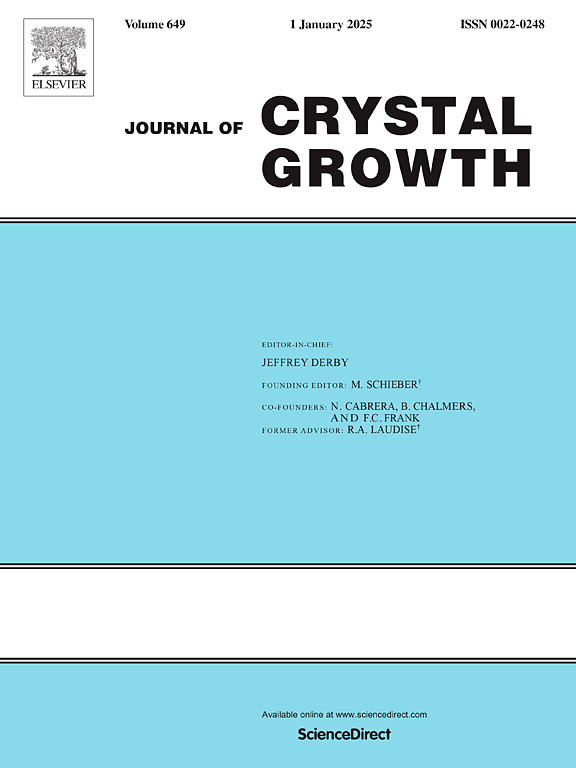Columnar dendritic growth during directional solidification of neopentylglycol-(d)camphor investigated under microgravity conditions
IF 1.7
4区 材料科学
Q3 CRYSTALLOGRAPHY
引用次数: 0
Abstract
We investigated dendritic solidification in the binary transparent organic model alloy neopentylglycol-(d)camphor under microgravity conditions onboard the International Space Station. Three cartridges containing alloys with hypoeutectic compositions of 0.2, 0.3 and 0.375 wt-frac. (d)Camphor were processed repeatedly in the “Transparent Alloys” solidification facility. In these Bridgman-type experiments, the dendritic grain structure − columnar, equiaxed or both mixed − was determined by in-situ optical observation as a function of alloy composition, crystallographic growth orientation, applied temperature field and cartridge withdrawal velocity. In most experiments, a columnar-equiaxed transition was achieved by increasing the cartridge velocity. We describe the experimental setup and procedure and focus on analysis of the columnar dendritic growth regime here. This includes estimates of the temperature gradient and supercooling at the columnar and eutectic front in combination with thermal modelling, as well as evaluation of a characteristic dendrite spacing. The results complement ground-based and other short-duration microgravity experiments in the same compositional range of the alloy. For eutectic growth, the undercooling increases linearly with cooling-rate. For columnar dendritic growth, the comparison of the kinetic law with previous experimental results exhibits similar trends but also significant deviations, which may be attributed to the different experimental set-up, data analysis and accuracy of temperature prediction. The determined characteristic dendrite spacing is well predicted by the models of Trivedi, Lu/Hunt and Ma/Sahm.
研究了微重力条件下新戊二醇-(d)樟脑定向凝固过程中柱状枝晶的生长
在国际空间站的微重力条件下,研究了二元透明有机模型合金新戊二醇-(d)樟脑的枝晶凝固。三盒含合金,亚共晶成分分别为0.2、0.3和0.375 wt-frac。(d)樟脑在“透明合金”凝固设施中反复加工。在这些bridgman型实验中,通过原位光学观察确定了枝晶晶粒结构-柱状,等轴状或两者混合-作为合金成分,晶体生长取向,应用温度场和筒体提取速度的函数。在大多数实验中,柱-等轴过渡是通过增加药筒速度来实现的。我们描述了实验设置和程序,并重点分析了柱状枝晶的生长机制。这包括结合热模拟对柱状和共晶锋面的温度梯度和过冷的估计,以及对特征枝晶间距的评估。该结果补充了在相同合金成分范围内进行的地面和其他短时间微重力实验。对于共晶生长,过冷度随冷却速率线性增加。柱状枝晶生长的动力学规律与前人的实验结果比较有相似的趋势,但也有明显的偏差,这可能与实验设置、数据分析和温度预测精度的不同有关。Trivedi、Lu/Hunt和Ma/Sahm模型很好地预测了确定的特征枝晶间距。
本文章由计算机程序翻译,如有差异,请以英文原文为准。
求助全文
约1分钟内获得全文
求助全文
来源期刊

Journal of Crystal Growth
化学-晶体学
CiteScore
3.60
自引率
11.10%
发文量
373
审稿时长
65 days
期刊介绍:
The journal offers a common reference and publication source for workers engaged in research on the experimental and theoretical aspects of crystal growth and its applications, e.g. in devices. Experimental and theoretical contributions are published in the following fields: theory of nucleation and growth, molecular kinetics and transport phenomena, crystallization in viscous media such as polymers and glasses; crystal growth of metals, minerals, semiconductors, superconductors, magnetics, inorganic, organic and biological substances in bulk or as thin films; molecular beam epitaxy, chemical vapor deposition, growth of III-V and II-VI and other semiconductors; characterization of single crystals by physical and chemical methods; apparatus, instrumentation and techniques for crystal growth, and purification methods; multilayer heterostructures and their characterisation with an emphasis on crystal growth and epitaxial aspects of electronic materials. A special feature of the journal is the periodic inclusion of proceedings of symposia and conferences on relevant aspects of crystal growth.
 求助内容:
求助内容: 应助结果提醒方式:
应助结果提醒方式:


